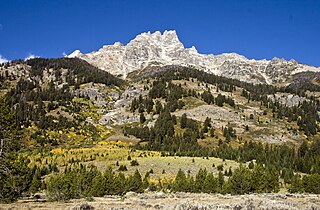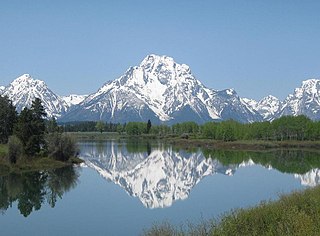
Grand Teton National Park is an American national park in northwestern Wyoming. At approximately 310,000 acres (1,300 km2), the park includes the major peaks of the 40-mile-long (64 km) Teton Range as well as most of the northern sections of the valley known as Jackson Hole. Grand Teton National Park is only 10 miles (16 km) south of Yellowstone National Park, to which it is connected by the National Park Service–managed John D. Rockefeller Jr. Memorial Parkway. Along with surrounding national forests, these three protected areas constitute the almost 18-million-acre (73,000-square-kilometer) Greater Yellowstone Ecosystem, one of the world's largest intact mid-latitude temperate ecosystems.

A pyramidal peak, sometimes called a glacial horn in extreme cases, is an angular, sharply pointed mountain peak which results from the cirque erosion due to multiple glaciers diverging from a central point. Pyramidal peaks are often examples of nunataks.

Grand Teton is the highest mountain in Grand Teton National Park, in Northwest Wyoming, and a classic destination in American mountaineering.

Mount Moran is a mountain in Grand Teton National Park of western Wyoming, USA. The mountain is named for Thomas Moran, an American western frontier landscape artist. Mount Moran dominates the northern section of the Teton Range rising 6,000 feet (1,800 m) above Jackson Lake. Several active glaciers exist on the mountain with Skillet Glacier plainly visible on the monolithic east face. Like the Middle Teton in the same range, Mount Moran's face is marked by a distinctive basalt intrusion known as the Black Dike.

Mount Owen is the second highest peak in the Teton Range, Grand Teton National Park in the U.S. state of Wyoming. The peak is named after William O. Owen, who organized the first documented ascent of the Grand Teton in 1898. Mount Owen is part of the Cathedral Group of high Teton peaks, a collection of peaks in the central section of the range that are particularly rugged. The 40-mile (64 km) long Teton Range is the youngest mountain chain in the Rocky Mountains, and began its uplift 9 million years ago, during the Miocene. Several periods of glaciation have carved Mount Owen and the other peaks of the range into their current shapes. Valhalla Canyon is situated on the west slopes of Mount Owen.

Middle Teton is the third-highest peak in the Teton Range, in the U.S. state of Wyoming. Located within Grand Teton National Park, the peak is immediately southwest of Grand Teton, from which it is separated by a broad high ridge at 11,600 feet (3,540 m), known to local climbers as the Lower Saddle. The Middle Teton Glacier is located on the eastern slopes of the peak.

Teewinot Mountain is the sixth highest peak in the Teton Range, Grand Teton National Park, Wyoming. The name of the mountain is derived from the Shoshone Native American word meaning "many pinnacles". The peak is northeast of the Grand Teton, and the two are separated from one another by the Teton Glacier and Mount Owen. Teewinot Mountain rises more than 5,500 feet (1,700 m) above Jenny Lake. The 40 miles (64 km) long Teton Range is the youngest mountain chain in the Rocky Mountains, and began their uplift 9 million years ago, during the Miocene. Several periods of glaciation have carved Teewinot Mountain and the other peaks of the range into their current shapes. Broken Falls is one of the tallest cascades in Grand Teton National Park and descends 300 feet (91 m) down the eastern slopes of Teewinot Mountain.

South Teton is the fifth-highest peak in the Teton Range, Grand Teton National Park, in the U.S. state of Wyoming. The peak is south of Middle Teton and just west of Cloudveil Dome and is part of the Cathedral Group of high Teton peaks. The 40-mile-long (64 km) Teton Range is the youngest mountain chain in the Rocky Mountains, and began their uplift 9 million years ago, during the Miocene. Several periods of glaciation have carved South Teton and the other peaks of the range into their current shapes.

Signal Mountain is an isolated summit standing 7,720 feet (2,350 m) above sea level. The mountain is located in Grand Teton National Park in the U.S. state of Wyoming. The next closest higher summit is more than 10 miles (16 km) distant, and this isolation provides sweeping views of the Teton Range, much of the northern Jackson Hole area as well as the Snake River. Though located adjacent to the Tetons, Signal Mountain was not formed in the same manner or period. The mountain originally was formed by volcanic ashfall from one of the eruptions of the Yellowstone hotspot. The peak is also partially a glacial moraine formed by a receding glacier that came south out of the Yellowstone icecap. This same glacier also created neighboring Jackson Lake.

Thor Peak is in the northern Teton Range, Grand Teton National Park, in the U.S. state of Wyoming. Mount Moran is 1 mile (1.6 km) to the east. The summit is the eighth-highest in the Teton Range. Several semi-permanent snowfields as well as the Triple Glaciers are located on the east and northern slopes of the mountain. While the easiest route up the mountain, the south slope, is only rated a class 4, the mountain's remoteness and difficulty of approach make it a challenging mountain to summit.

Symmetry Spire is located in the Teton Range, Grand Teton National Park in the U.S. state of Wyoming. The mountain, first climbed via the east ridge route on August 20, 1929, by Fritiof Fryxell and Phil Smith, towers above the northwest shore of Jenny Lake and Cascade Canyon. The scenic Lake of the Crags, a cirque lake or tarn, is located northwest of the summit and is accessed by way of Hanging Canyon. Popular with mountaineers, the spire has numerous challenging cliffs.

Middle Teton Glacier is on the northeast flank of Middle Teton in Grand Teton National Park, Wyoming. The alpine glacier is a popular mountaineering route for ice climbing and for access to the summit of Middle Teton and other peaks to the south. The glacier is at the west end of Garnet Canyon, which is the most popular route used by climbers ascending Grand Teton. The glacier melt feeds streams below including Spalding Falls, an 80 ft (24 m) high cascade. Between 1967 and 2006, Middle Teton Glacier lost approximately 25 percent of its surface area, shrinking from 52 to 39 acres.

Teton Glacier is a mountain glacier located below the north face of Grand Teton in Grand Teton National Park, Wyoming, United States. Its neighbors are Mount Owen to the west and Teewinot Mountain to the north. Teton Glacier is the largest of the twelve named glaciers in the park. In 1971, the glacier was approximately 3,500 ft (1,100 m) long and 1,100 ft (340 m) wide. Between 1967 and 2006, Teton Glacier lost approximately 14 to 20 percent of its surface area, a reduction from 64 to 53 acres.

Falling Ice Glacier is located in the Grand Teton National Park, Wyoming, United States. The glacier is situated on the southeastern cliffs of Mount Moran and can be seen from Jackson Hole. Runoff from the glacier flows into Leigh Lake. The glacier is located in a high altitude cirque and is along one of the major climbing routes to the summit of Mount Moran. All of the existing glaciers in Grand Teton National Park were created during the Little Ice Age (1350–1850 A.D.) and have been in a general state of retreat since the mid-19th century.
Triple Glaciers are in Grand Teton National Park, Wyoming, United States. The glaciers are disconnected from each other and occupy three separate cirques on the northwest face of Mount Moran and northeast of Thor Peak. The glaciers are unofficially referred to as East, Middle and West Triple Glacier.

Petersen Glacier is in Grand Teton National Park, Wyoming, United States. The glacier is in a cirque to the west and above north Cascade Canyon at an altitude of approximately 10,000 feet (3,000 m). The glacier is named after Frank Petersen, one of the first mountaineers to climb Grand Teton in 1898. Runoff from the glacier is heavy in rock flour which turns the waters of Mica Lake turquoise in appearance. The glacier is no longer visible in satellite imagery, indicating it may have disappeared. All of the existing glaciers in Grand Teton National Park were created during the Little Ice Age (1350-1850) and have been in a general state of retreat since the mid-19th century.

Moran Canyon is located in Grand Teton National Park, in the U. S. state of Wyoming. The canyon lies between Mount Moran to the south and Traverse Peak and Bivouac Peak to the north. Moran Bay, part of Jackson Lake, is at the mouth of the canyon to the east. The canyon was formed by glaciers which retreated at the end of the last glacial maximum approximately 15,000 years ago.

The canyons of the Teton Range lie almost entirely within Grand Teton National Park in the U.S. state of Wyoming. Ranging from 9 miles (14 km) to less than 1 mile (1.6 km) in length and up to 6,000 feet (1,800 m) deep, the canyons were carved primarily by glaciers over the past 250,000 years. The canyons in the Teton Range descend in altitude generally west to east and many have lakes at their outlets. The lakes were created by terminal moraines left behind by the now retreated glaciers. A few of the canyons have small glaciers that were created mostly during the Little Ice Age (1550-1850). Fast retreating Schoolroom Glacier is a tiny glacier located at the head of the South Cascade Canyon. Most of the canyons have streams from which rain and snowmelt flow towards Jackson Hole valley, and due to the sometimes rapid altitude descent, waterfalls are common. The canyons offer the easiest hiking access into the Teton Range.

Leigh Canyon is located in Grand Teton National Park, in the U. S. state of Wyoming. The canyon was formed by glaciers which retreated at the end of the last glacial maximum approximately 15,000 years ago, leaving behind a U-shaped valley. Leigh Canyon is approximately 6 miles (9.7 km) long and is flanked by Mount Moran and Thor Peak to the north and Mount Woodring to the south. The canyon outlet is at Leigh Lake and at the head of the canyon lies Mink Lake.


















